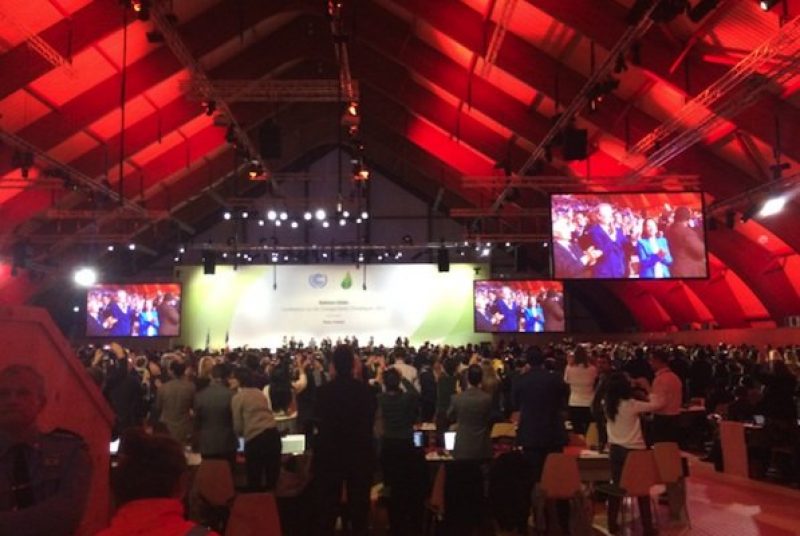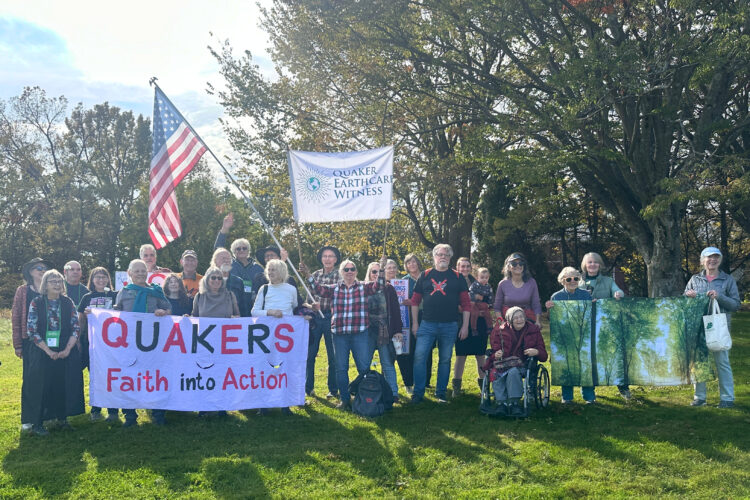Reflections on COP21 and the Paris Negotiations

By Philip Emmi, QEW-Accredited COP21 Observer
How can one describe an event designed to accommodate 40,000 attendees and reach an agreement among 195 countries on how to protect against catastrophic climate disruption? Dante’s circles of Heaven and Hell may be a useful image.
The venue was located at Paris’s Le Bourget Conference Center. Hall 1 was the innermost circle. It was reserved for the UNFCCC functionaries and the French Presidency headed by French Foreign Minister, Laurent Fabius. His task was to orchestrate negotiations among delegates and produce what would be known as the Paris Agreement.
Framing these negotiations are the national emission reduction targets each country recently submitted. In total, these were roughly 50 percent short of required emissions for a less-than-2C world. Major developed countries fell well short of committing to their fair share, and their fair shares are too large to be met within their boundaries. Most developing countries committed fairly to their share, but they failed to exploit their far greater mitigation potential. So central to the COP21 negotiations was the question of how could developed countries help empower developing countries to make up the global commitment shortfall. And would they?
This question meant negotiators had to navigate a thicket of principles and issues. The most difficult of these was the principle of common but differentiated responsibilities and differentiated capabilities. Other issues included the balance between mitigation and adaptation, the agreement’s status as a legally binding instrument, and the ambitiousness of the global temperature goal. In addition, there were questions regarding global financial support, technology transfer, institutional capacity building, and transparency and accountability.
To help keep negotiators well informed, the French Presidency and its Lima predecessor organized the Paris Lima Action Agenda. It provided a chorus of thematic events on forests, agriculture, oceans, water, resilience, adaptation, transport, buildings, finance, energy, innovation, and business plus local and municipal authorities. This was the next innermost circle
Civil society offices occupied the third innermost circle. This space was reserved for representatives from environmental NGOs, local governments and municipal authorities, indigenous peoples organizations, business and industry associations, trade unions, research and independent NGOs, women’s rights organizations, youth organizations, and farmer organizations. There people met, worked, and sought to shape the terms of negotiation.
The fourth innermost circle was the side-events room, an airplane hanger-sized space with more than 100 information booths and side-event meeting rooms. Here one could meet and hear from people doing research, organizing around thematic interests, and taking action on the ground.
These elements formed an inner zone designated the blue zone. Collectively, work in the blue zone was dedicated to defining goals, setting objectives, and delineating programs, mechanisms, and implementation tools that would ultimately be collected in the form of a binding agreement specifying actions to be taken and defining a pathway toward stronger commitments in the future.
Outside this inner sanctum was a green zone, a huge, loosely organized space open to the general public for debates, knowledge-sharing, discussions, and conviviality. This was a lively space shared by many of the same organizations listed above.
Beyond the Le Bourget site, scattered throughout Paris were numerous venues where proponents of civil society, trade unionists, and social movement activists met to draft vision statements, organize social actions, craft slogans, create artistic representations, and motivate adherents to continued participation. Instead of the formal language of diplomacy and bureaucratic action, one would hear calls for a just transition to a fair economy, a healthy society, and a clean environment. This is where one would speak of fundamental rights, social solidarity, inclusion, responsibility, standing, and voice. Though unofficial, these events demonstrated a deep desire for change and so were an integral part of COP21.
So was COP21 a success? Well, compared to what? Relative to the US Congress, it was comparatively successful in finding grounds for compromise. Compared to the accomplishments of prior Conferences of Parties, it was a great success. Compared to what is required to respond to climate dynamics, the Paris Agreement failed to be sufficiently ambitious. Compared to what concrete actions were needed, it at least offered a solid beginning. It also set out a pathway guaranteeing accelerated responses over time. Wisely, it did not look to the free market as a universal solution to its problems. It did strongly signal a transition away from fossil fuels and toward efficiency and renewable energy. Its success will be best gauged during implementation. The Paris Agreement did not save us from climate catastrophe (that’s a collective responsibility), but neither did it close down the continuing chance to do so.

